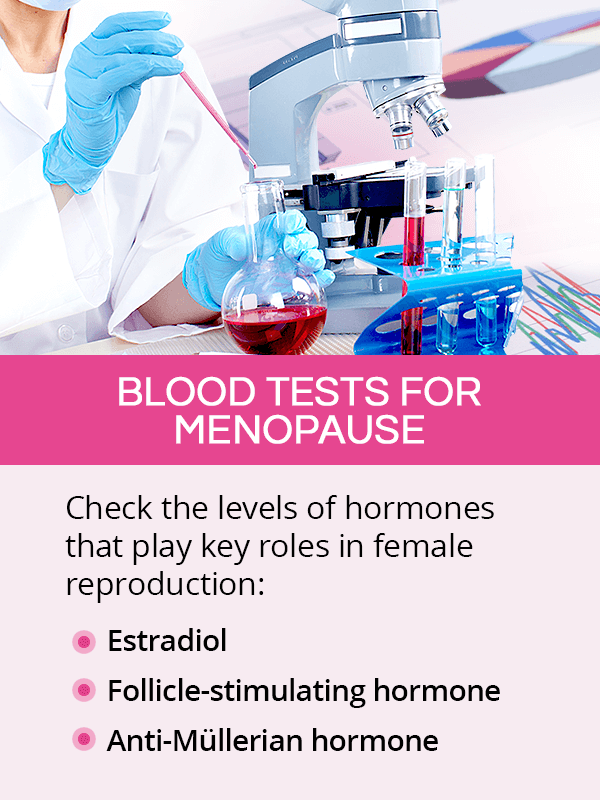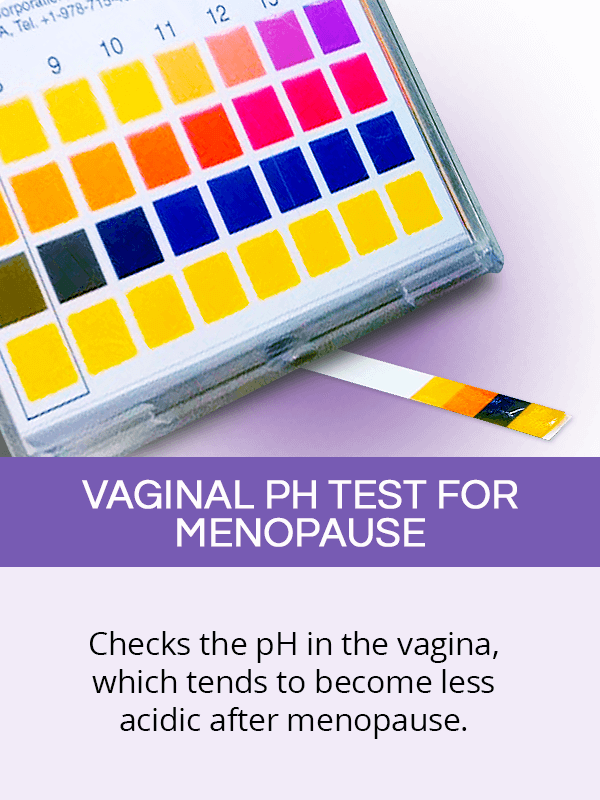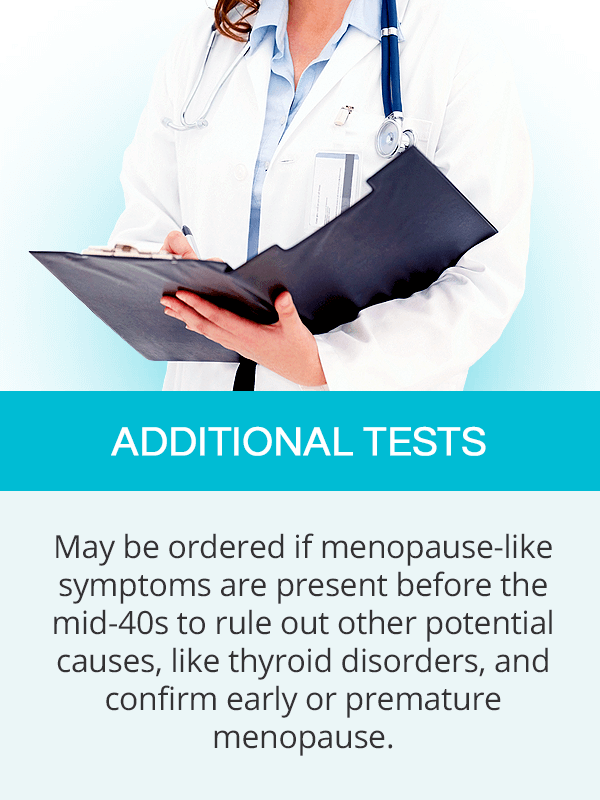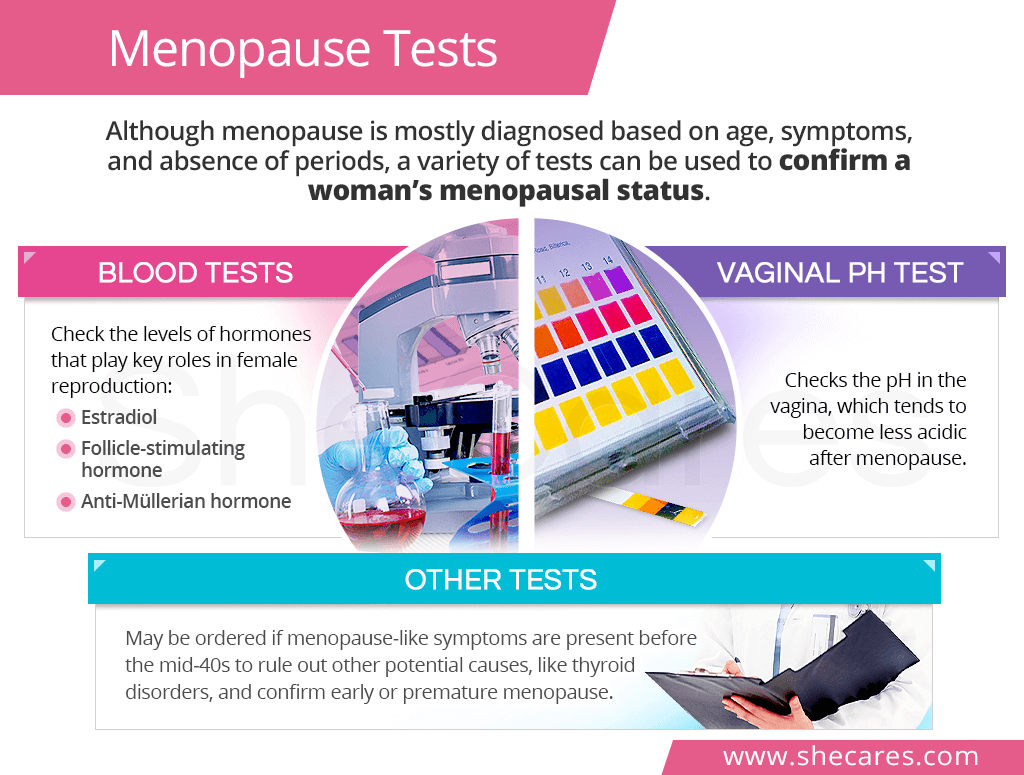Blood Tests for Menopause

There are three types of blood work for menopause that a woman's healthcare provider might order, each of which checks for levels of different reproductive hormones.
In most cases, these blood tests are not done until a woman has gone without a period for 12 months in a row; in other words, they are done once she has reached menopause.1 This is because erratic hormonal fluctuations during perimenopause may render them inaccurate.
Estradiol Hormone Blood Test
Estradiol is a form of the estrogen hormone whose levels can be measured to determine a woman's menopausal status. Estradiol levels normally fluctuate throughout the menstrual cycle, ranging between 30 to 400 pg/mL. After her final period, however, they drop below 30 pg/mL.2
Such low estrogen levels in postmenopausal women happen as the ovaries run out of their supply of eggs. Those ovarian eggs are stored in follicles, which produce estrogen. Once the ovarian reserve nears depletion in the mid-40s, estrogen levels begin to fluctuate and eventually drop drastically, ending women's fertility.
Follicle-Stimulating Hormone (FSH) Blood Test
Another type of blood menopause test measures the levels of FSH, a hormone that stimulates the aforementioned follicles to mature eggs and produce estrogen, hence its name. Depending on the point of the menstrual cycle, normal FSH levels range from 1.1-17.2 IU/mL. In postmenopausal women, however, its levels increase to between 19 to 100 IU/mL.3
FSH works hand-to-hand with other reproductive hormones, including estrogen, progesterone, and luteinizing hormone (LH). Since it stimulates the follicles to produce estrogen, a natural, age-related depletion of those follicles causes estrogen levels to drop. At the same time, FSH increases as there is not enough estrogen to halt its production.
Anti-Müllerian Hormone Blood Test
A newer menopause lab test, PicoAMH Elisa (marketed as MenoCheck®) assesses the levels of anti-Müllerian hormone (AMH). Since AMH is produced in the ovarian follicles that decrease over time, its levels also drop with age. As such, younger women's levels will range between 3.0 ng/mL and 1.5 ng/mL, while those of women after 45 will be 0.5. ng/mL and below.4
For women of reproductive age, an AMH blood test is used as an assessment tool for infertility and menstrual disorders. When used to determine women's menopausal status, PicoAMH Elisa is recommended to be analyzed alongside other clinical evaluations and laboratory findings.
Vaginal pH Test for Menopause

Besides hormone tests for menopause, a woman may also undergo a vaginal pH test. This non- invasive diagnostic tool is a simple way to confirm her menopausal status based on her vaginal environment. Results of pH ranging between 4.5 and 7.5 are consistent with postmenopause.5
Until a woman enters the midlife transition, estrogen plays a role in maintaining a moderately acidic vaginal pH (below 4.5). This is the body's way to prevent infections of the reproductive tract. With the arrival of menopause, however, estrogen levels go down, causing vaginal pH to become less acidic.
Additional Tests

Other tests might also be used if a woman experiences menopause symptoms at a younger age, that is, before she reaches her mid-40s.
A variety of conditions may cause menopause-like discomforts, including thyroid disorders. As such, those tests are aimed at diagnosing other potential causes, or confirming early menopause (menopause between the ages of 40 and 45) or premature menopause (one that occurs before the age of 40).
Key Takeaways
When the long-anticipated menopause symptoms finally appear, women may feel eager to undergo tests to confirm their entry into the transition. However, the massive hormonal shifts that take place in the years leading up to women's final periods alter the results of menopause lab tests. As such, they are typically done after women did not have their periods for a year and are about to enter postmenopause. At this stage, hormone levels stabilize, and women can take several blood tests for menopause, including estrogen, FSH, and anti-Müllerian hormone tests. They can also have their vaginal pH checked to confirm their menopausal status. In some cases, doctors may also confirm menopause merely on experienced symptoms, women's age, and absence of periods, without running any menopause tests.
Sources
- BreastCancer.org. (2020). Tests to Determine Menopausal Status. Retrieved March 12, 2021 from https://www.breastcancer.org/tips/menopausal/types/determine-status
- Endocrinology and Metabolism Clinics of North America. (2020). Endocrinology of the Menopause. Retrieved March 12, 2021 from https://www.ncbi.nlm.nih.gov/pmc/articles/PMC6983294/
- Journal of Clinical Endocrinology & Metabolism. (2019). Can Menopause Prediction Be Improved with Multiple AMH Measurements? Retrieved March 12, 2021 from https://academic.oup.com/jcem/article/104/11/5024/5475549?searchresult=1
- Medline Plus. (2020). Anti-Müllerian Hormone Test. Retrieved March 12, 2021 from https://medlineplus.gov/lab-tests/anti-mullerian-hormone-test/
- Medline Plus. (2020). Follicle-Stimulating Hormone (FSH) Levels Test. Retrieved March 12, 2021 from https://medlineplus.gov/lab-tests/follicle-stimulating-hormone-fsh-levels-test/
- MenoCheck®. (n.d.). For Women - Determining menopausal status is important to all women. Retrieved March 12, 2021 from https://menocheck.com/women/
- Menopause. (2020). Baseline estrogen levels in postmenopausal women participating in the MAP.3 breast cancer chemoprevention trial. Retrieved March 12, 2021 from https://www.ncbi.nlm.nih.gov/pmc/articles/PMC7469568/
- Menopause. (2018). Vaginal pH: a simple assessment highly correlated with vaginal morphology and symptoms in postmenopausal women. Retrieved March 12, 2021 from https://journals.lww.com/menopausejournal/Abstract/2018/07000/Vaginal_pH__a_simple_assessment_highly_correlated.9.aspx
- Saudi Medical Journal. (2010). Can vaginal pH predict menopause? Retrieved March 12, 2021 from https://pubmed.ncbi.nlm.nih.gov/20231928/
- The North American Menopause Society. (n.d.). Changes in Hormone Levels. Retrieved March 12, 2021 from https://www.menopause.org/for-women/sexual-health-menopause-online/changes-at-midlife/changes-in-hormone-levels
- The North American Menopause Society. (n.d.). How Do I Know When I'm in Menopause? Retrieved March 12, 2021 from https://www.menopause.org/for-women/menopauseflashes/menopause-symptoms-and-treatments/how-do-i-know-when-i%27m-in-menopause-
- The North American Menopause Society. (n.d.). Overview of Menopause. Retrieved March 12, 2021 from https://www.menopause.org/publications/clinical-care-recommendations/chapter-1-menopause
Footnotes:
- Cleveland Clinic. (2019). Menopause, Perimenopause and Postmenopause. Retrieved March 12, 2021 from https://my.clevelandclinic.org/health/diseases/15224-menopause-perimenopause-and-postmenopause
- University of Rochester Medical Center. (n.d.). Estradiol (Blood). Retrieved March 12, 2021 from https://www.urmc.rochester.edu/encyclopedia/content.aspx?ContentTypeID=167&ContentID=estradiol
- University of Rochester Medical Center. (n.d.). Follicle-Stimulating Hormone. Retrieved March 12, 2021 from https://www.urmc.rochester.edu/encyclopedia/content.aspx?contenttypeid=167&contentid=follicle_stimulating_hormone
- American Journal of Obstetrics & Gynecology. (2017). Ovarian reserve testing: a user's guide. Retrieved March 12, 2021 from https://www.ajog.org/article/S0002-9378(17)30300-9/pdf
- Journal of Mid-Life Health. (2014). Vaginal pH: A marker for menopause. Retrieved March 12, 2021 from https://www.ncbi.nlm.nih.gov/pmc/articles/PMC3955044/
